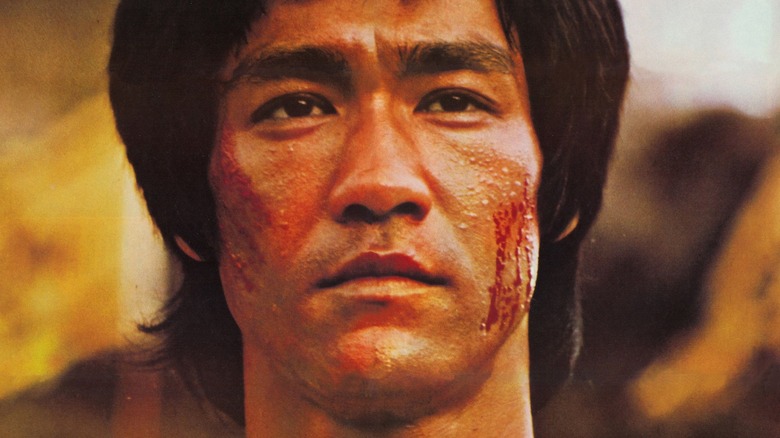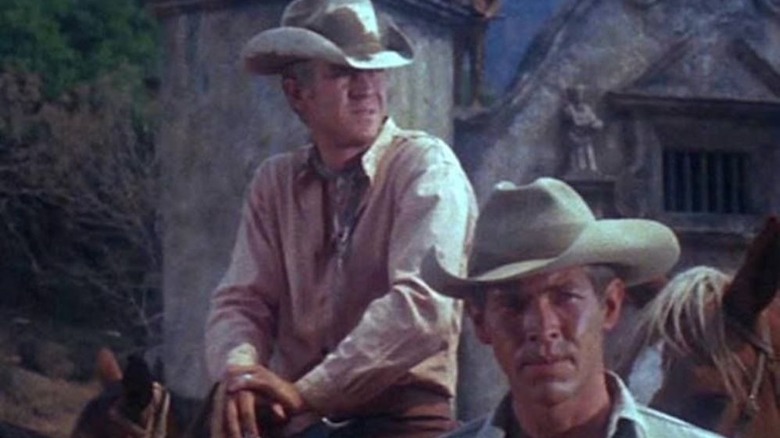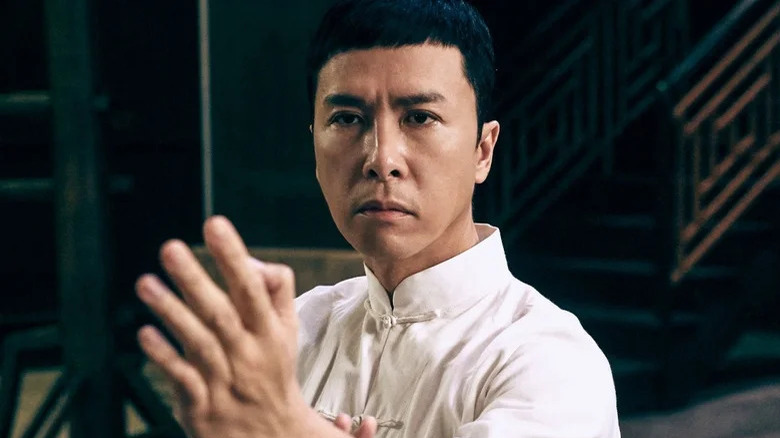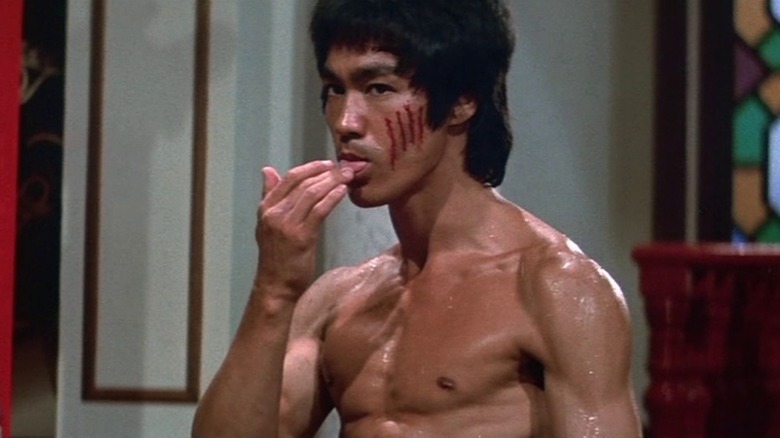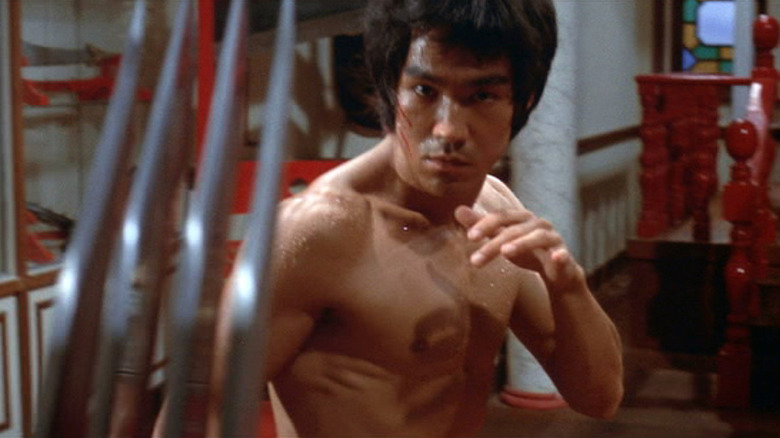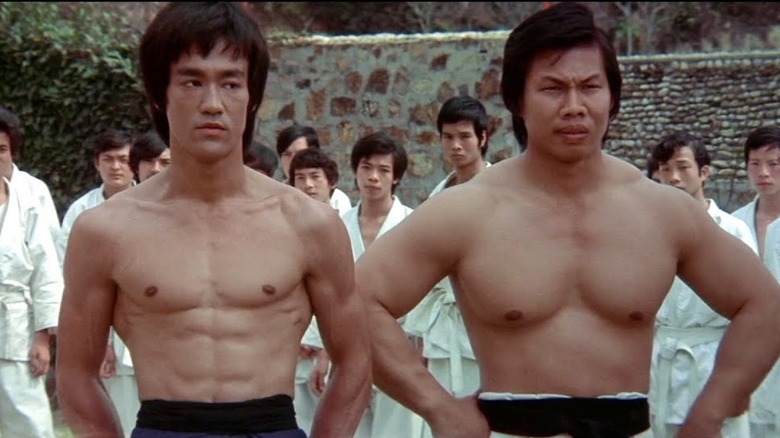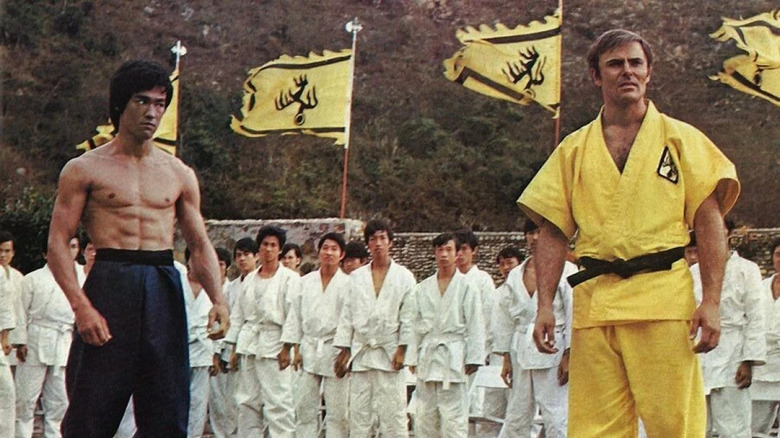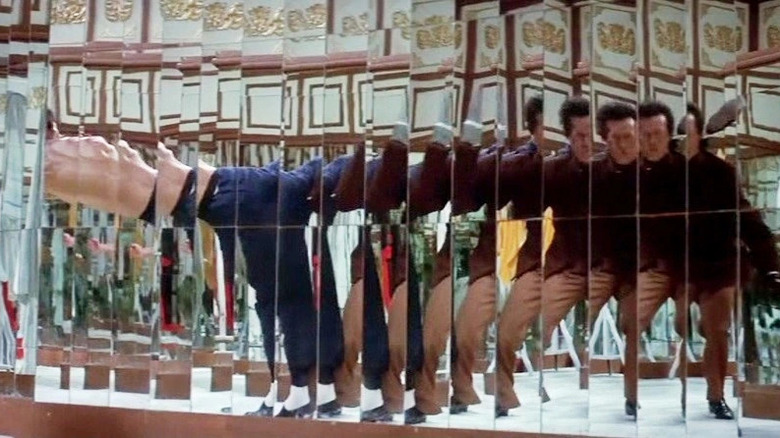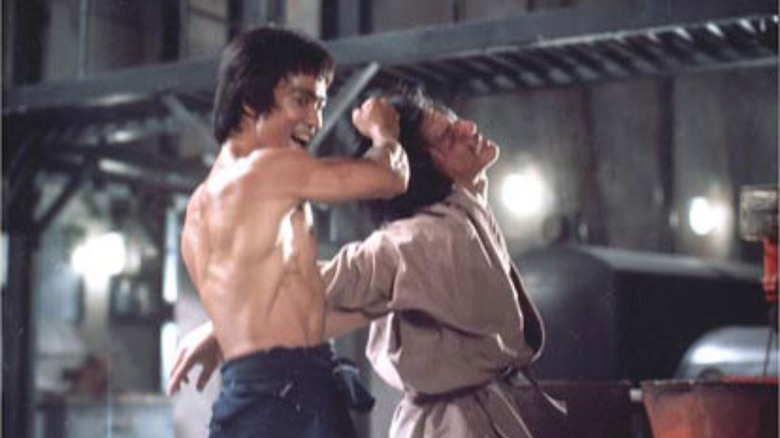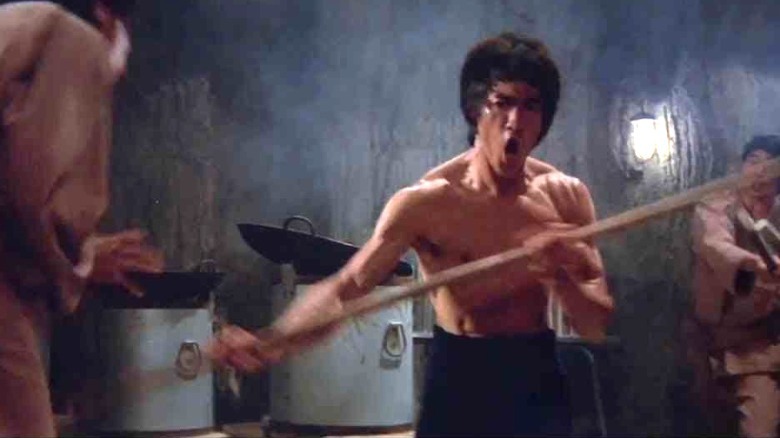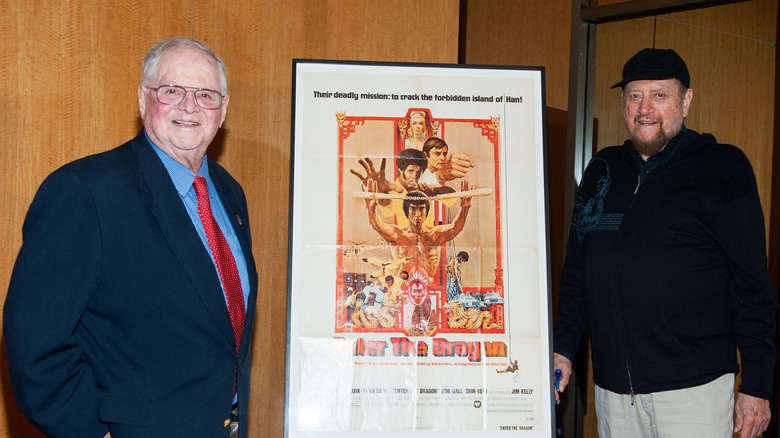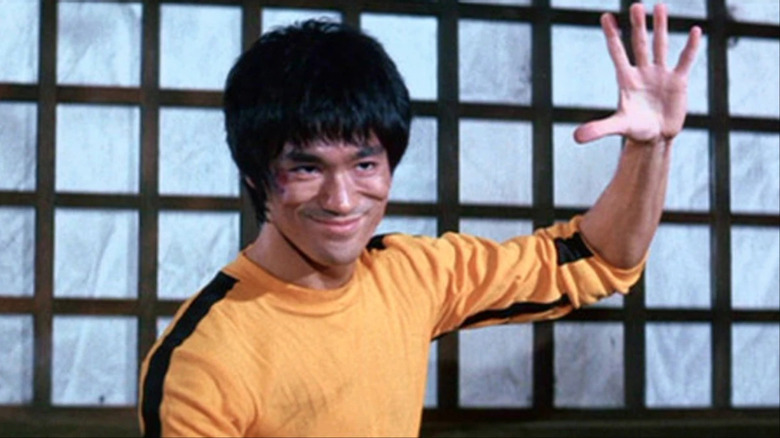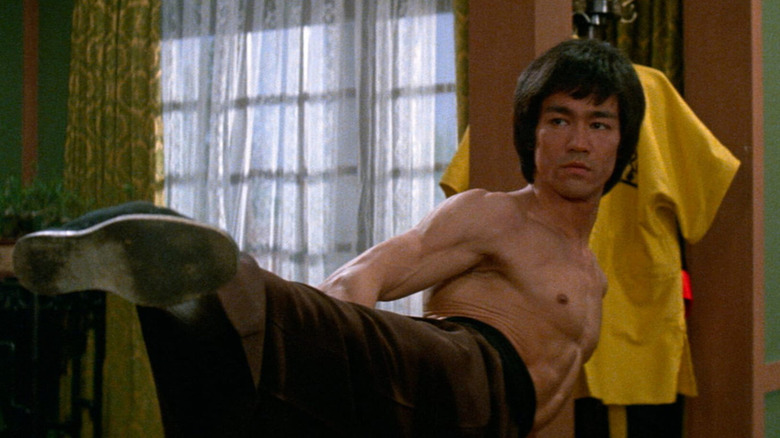How Enter The Dragon Became A Martial Arts Masterpiece
"Be water, my friend," Bruce Lee famously said. That statement, key to Lee's Jeet Kun Do martial arts technique and philosophy, means you are fluid and adaptable, but also that you can strike hard and fast at the moment you need to. Lee developed that philosophy over years of fighting, both in the streets of Hong Kong and in San Francisco as an Asian-American immigrant. Having grown up acting and studying wing chun, Lee had to create his own path to realize his own dreams.
Lee wanted to become a big Hollywood star, but after being rebuffed over and again, he had to go to Hong Kong to make the movies he wanted. At the time, the Shaw Brothers had all but invented the genre of kung fu movies (via BFI), influencing later artists ranging from the Wu-Tang Clan to Quentin Tarantino. Yet when Lee began to develop his own films, he decided to go in a different direction. He aligned with Raymond Chow's upstart Harvest Pictures instead.
Lee and Chow started with "The Big Boss," then made history with "Fist of Fury." Finally, with "The Way of the Dragon," Lee was big enough to get the attention of Hollywood, specifically Warner Bros. Pictures. Lee's career then took off with what many consider his best film, "Enter the Dragon," except that by the time it was released, he was no longer around to enjoy the impact that his passion project would have. Here's how "Enter the Dragon" became a martial arts milestone.
Bruce Lee had some serious clout with Hollywood A-listers
Bruce Lee didn't necessarily come to America to be a movie star. In fact, according to reports at the time, and Lee himself, he came to America to escape his growing life as a street criminal. In America he began teaching Wing Chun kung fu and gained a reputation as one of the best martial arts instructors in the country. For Lee, that meant he eventually had a star-studded cast of students.
Lee's student list would be the envy of any starstruck sensei. He taught Lee Marvin and Kareem Abdul-Jabbar. Roman Polanski and Sharon Tate were also apparently students (which is ironic, given Lee's portrayal in Quentin Tarantino's film and novel "Once Upon a Time in Hollywood"). He also trained martial arts legends Chuck Norris and Taky Kimura. According to several sources, James Coburn was Lee's favorite Hollywood student. Coburn was a pallbearer at Lee's funeral, as was Coburn's fellow "The Magnificent Seven" alum Steve McQueen. Given McQueen's lifelong reputation as one of Hollywood's true tough guys, his friendship (and rivalry) with Lee spoke to his deep respect for the man.
While Lee reportedly fell out with some of his A-list clients at times because of his own Hollywood ambitions, no doubt he learned some kernels of showbiz wisdom while teaching them how to throw kicks and punches like a true master.
Lee studied under a real master
If you're a fan of kung fu films, you've probably watched the "Ip Man" series. Ip Man (sometimes referred to as "Yip Man") was a real Wing Chun master. His skill was so legendary that he had a film series based on him, an honor attained by almost no other living sensei. It makes sense, then, that Ip Man was Lee's kung fu master. That also explains Lee's devotion to authenticity. Not only was he a legitimate martial artist, but the best way to honor his master and the man's teachings would be to authentically share them with a world audience. Perhaps not coincidentally, Raymond Chow's Golden Harvest, which really saw a breakthrough success with "Enter the Dragon," produced the "Ip Man" films.
Ip Man was such a legendary and skilled martial artist that not only did he inspire the four "Ip Man" films in the main series (five when you include "Master Z: The Ip Man Legacy") and several other standalone Ip Man films, he's also the focus of a film called "The Grandmaster." In fact, there are nine Ip Man films in total. The actor who plays Ip Man, Donnie Yen, would go on to American mainstream success for his role as a Force monk in "Rogue One: A Star Wars Story."
No doubt having trained under a real master, whose life also makes such compelling cinema, would influence Bruce Lee's films, including "Enter the Dragon."
The star had issues with the screenwriter
Although a major Hollywood studio, Warner Bros. Pictures, got behind "Enter the Dragon" and bet on Bruce Lee becoming a star, he still had trouble convincing the executives there of his vision.
According to Indiewire, Lee's daughter Shannon wrote in her book, "Be Water, My Friend: The Teachings of Bruce Lee," that her father battled the studio over the "Enter the Dragon" screenplay. As Shannon put it, "The original script had none of the iconic scenes that exist today." Warner Bros. reportedly brought in a screenwriter who didn't know much about kung fu. Lee protested and, according to Shannon, "feverishly rewrote the majority of the screenplay." Although Warner Bros. promised to get rid of the writer, the studio secretly sent him to Hong Kong instead to continue working on the script while not incorporating any of Lee's changes.
As a result, Lee did not show up to begin filming for two weeks, a standoff with the studio that he eventually won. His changes were utilized in the screenplay, and Lee made "Enter the Dragon" truly his film.
Enter the Dragon was originally titled Blood and Steel
Bruce Lee's issues with the film and script also included his dislike for the alternate titles that the studio wanted to use, including "Blood and Steel" and "Han's Island." The big problem seemed to be that the studio wanted a blood-filled fighting movie, while Lee wanted something more transcendent, steeped in the philosophical pursuits that had defined Lee's martial arts pursuits.
"Blood and Steel" hinted at a lurid action movie, which could be considered a draw for an audience whose knowledge of kung fu was limited at the time. It might have also been a reference to the steel-blade hand that the villainous Han (Kien Shih) busts out in his fight against Lee (Bruce Lee). "Han's Island" was a pretty on-the-nose title that simply explained the setting of the movie, at a tournament on opium kingpin Han's private atoll. "Enter the Dragon" gave the movie the depth that Lee brought to his martial arts and the "Dragon" in the title hinted at the Chinese heritage that was so important to Lee. It's tough now to imagine one of the most legendary martial arts movies of all time being called "Han's Island."
Most of the main actors were accomplished martial artists
For Lee, bringing legitimacy to his first big Hollywood film was everything. He wanted it to be genuinely Chinese, from the locations to the philosophies he'd studied. Even more important to him was the authenticity of the martial arts practiced in the movie since Lee was first and foremost a martial artist.
John Saxon, who played Roper, trained in judo and karate for years before "Enter the Dragon." Jim Kelly, who handled the role of Williams, was a black belt and international karate champion (though he and other martial artists of color had quite the struggle making it in the martial arts world of the '70s and '80s). Kien Shih, who played Han, had been training in martial arts for most of his life and starred in several hundred martial arts films. Bob Wall, Angela Mao — also known as Lady Kung Fu – Bolo Yeung, and Sammo Hung were a few of the other big names in martial arts to round out the cast.
WB made it a double lead due to Lee's race
According to Variety, racial issues also affected Lee's big studio film with Warner Bros. Lee had long dealt with racism and intolerance in America, but Shannon Lee explained in her book how Warner Bros. was influenced by the racial sentiments of the time. '"Enter the Dragon' was the dream opportunity coming true for my father — a Hollywood feature for him to star in," she wrote. "That said, Hollywood billed it as a double lead in case their gamble on my father didn't pay off, and in part due to the intense prejudice and concern surrounding the xenophobia of audiences of that time."
It's tough to tell who the studio considered as the film's co-lead. Jim Kelly and John Saxon both share coverage on the movie poster. Kelly was an American and a great martial artist but he was black. Saxon was American and white. Either way, according to Shannon Lee, the studio didn't think one Chinese man would be able to carry the film, regardless of the fact that he essentially created it and was arguably the best martial artist of his generation. Thankfully, Lee's role as a champion of Asian culture continues today in the endless influence his philosophy and his films continue to have.
The mirror room scene was a challenge to shoot
One of the most eye-catching scenes in "Enter the Dragon" is the one where Han lures Lee into a hall of mirrors. The disorienting nature of that scene isn't just a camera trick — it was actually a tough scene to execute. They had to build a closet full of mirrors, then shoot inside it despite all the challenges of reflection, lighting, and movement that could crop up in a fully mirrored interior.
Cinematographer Phil Hubbs went through the process in a recent Q&A about the film. According to Hubbs, the sequence was director Robert Clouse's idea. When they shot it, they would cut a hole in a different spot in the mirrored wall to move with Bruce to a different location. "That complicated the image a lot because we were shooting into a mirror and the mirror bounced all around," Hubbs explained. "You actually got nauseous in the room. Bruce banged himself into the mirrors a whole bunch."
Jackie Chan was an unnamed extra
For a movie that was so financially successful ($21 million — more than $140 million today — at the box office from an $850,000 budget) and had such a lasting legacy, you might be struck by how few household names star in it. In fact, the only actor from the movie who would go on to achieve stardom was an unnamed extra. A young martial artist named Jackie Chan played one of the random fighters that Bruce Lee defeats in "Enter the Dragon."
Chan would continue making movies, gaining attention for "Drunken Master" in 1978 and then the "Police Story" series. It should be noted that both were produced by Golden Harvest, the company owned by Raymond Chow that got a huge boost from Bruce Lee's films. Most Western audiences first discovered him in "Rush Hour," and he's been in seemingly countless Hollywood action films since. Given his eventual success in and acceptance by the Hollywood machine, drawing comparisons between Lee's potential and Chan's career are inevitable.
Some of the extras challenged Lee to fights
Since "Enter the Dragon" was a martial arts film shot in Hong Kong with a mostly Chinese cast, there was bound to be some peacocking. The extras had some training, as evidenced by the fact that Jackie Chan himself was one of those extras. Supposedly, one of the extras actually challenged Lee to a real fight. Many people wanted to test Lee's fighting skills, as is standard within the martial arts community.
According to a vintage interview with cast member Bolo Yeung (via Screenrant), Lee was too fast for his challenger and won, although the adept did land a few blows. Yeung himself called Lee's speed "incredible." In the end, whether participating in a choreographed or actual fight, it seems Lee couldn't be defeated by fist, foot, or weapon. That is why he will eternally be a martial arts legend, and why "Enter the Dragon" stands as a landmark in its genre.
Enter the Dragon was the studio's top international film of 1973
The budget for "Enter the Dragon" was $850,000, which might seem low, but at the time there had been no big Hollywood martial arts movies. Producer Fred Weintraub explained in a Q&A (via Collider) that it was tough to get the funding. "I had to go to foreign [investment]," he recalled. "[The foreign guy] told me 'Well I can get you two or three hundred thousand out of the Far East.' And I said 'That's all?'" Apparently the Chinese market was not interested in seeing an American film starring a Chinese actor. After that, Weintraub approached Warner Bros. co-owner Ted Ashley to ask for another $300,000, which Ashley agreed to provide with the condition that he did not spend a dime more.
This hustle paid off in spades, however. "Enter the Dragon" landed at number 13 on the list of top-grossing films of 1973. It was Warner Bros.'s third highest-grossing film of the year, behind horror classic "The Exorcist" and Clint Eastwood's "Magnum Force." "Enter the Dragon" not only showed that martial arts movies could play in America, it showed that they could dominate, with the movie ultimately earning more than $21 million in the U.S. alone.
Enter the Dragon was Lee's only Hollywood studio film
Fred Weintraub was a nightclub-owner-turned-producer at Warner Bros. who had learned about Lee through his Golden Harvest films and wanted to make a Hollywood picture with him, according to an interview with Weintraub by Black Belt magazine. When Warner Bros. finally produced "Enter the Dragon," it was Lee's first great exposure on American soil (aside from his role as Kato in the short-lived 1966 TV series "The Green Hornet"). After the success of Lee's Hong Kong movies, he was finally able to make a movie in Hollywood and make it on his terms.
Unfortunately, during what should have been Lee's great moment of glory, the premiere of his first Hollywood film, Lee wasn't present. The movie premiered on August 19, 1973, but Lee had already died (via History) on July 20 of the same year. The cause of death was a cerebral edema, or swelling of the brain. So Bruce Lee missed the opening of the movie that should have been his great mainstream breakout but was instead his final legacy. He died while filming his next movie, "Game of Death," which might have cemented him as Hollywood's next great leading man and first true martial arts star.
The film introduced martial arts to Western audiences
You would be hard-pressed to find a Hollywood film featuring martial arts before "Enter the Dragon," much less focusing on it. A great example of how things changed is found in the zeitgeist-following James Bond movies. In "Goldfinger," the only martial artist is a powerfully built man of unnamed Asian descent whose skills consist mostly of him being very strong and throwing a steel-lined hat. In 1967's "You Only Live Twice," Bond goes to a ninja school whose students are used as a mercenary army. By "The Man with the Golden Gun," which came out in 1974, Bond puts on a gi and does karate himself.
When people talk about classic kung fu movies, they're often referring to the movies produced by (or following the pattern of the ones produced by) the Shaw Brothers in Hong Kong, which at the time were mostly only hits in China (though some were dubbed for U.S. audiences as a sort of test). After "Enter the Dragon," American action movies began to feature choreographed martial arts fights. According to the Chronicle, martial arts swept the U.K. and North America in the early 1970s and never left. Carl Douglas said it best in his 1974 hit song: "Everybody was kung fu fighting."
